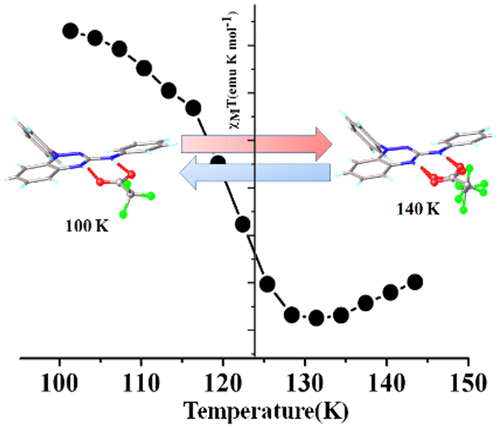当前位置:
X-MOL 学术
›
Cryst. Growth Des.
›
论文详情
Our official English website, www.x-mol.net, welcomes your feedback! (Note: you will need to create a separate account there.)
Reversible Magnetic Transition in a Bench-Stable Radical Cation Triggered by Structural Transition in the Magnetically Silent Counteranion
Crystal Growth & Design ( IF 3.8 ) Pub Date : 2020-09-11 , DOI: 10.1021/acs.cgd.0c00881 Abhik Paul 1 , Rajendar Nasani 1 , Arpan Mondal 1 , Subhadip Roy 1, 2 , Sergi Vela 3 , Sanjit Konar 1
Crystal Growth & Design ( IF 3.8 ) Pub Date : 2020-09-11 , DOI: 10.1021/acs.cgd.0c00881 Abhik Paul 1 , Rajendar Nasani 1 , Arpan Mondal 1 , Subhadip Roy 1, 2 , Sergi Vela 3 , Sanjit Konar 1
Affiliation

|
Fabrication of bench-stable radical ions under ambient conditions is of utmost significance from the perspective of materials and structural (solid-state) chemistry. Two exceptionally stable benzotriazinyl radical cationic salts of 1-phenyl-3-(phenylamino)-1,2,4-benzotriazin-4-ium-1-ylium (A and B) have been prepared and structurally characterized for the first time, in which the hydrogen bonding controls their supramolecular arrangement, and thus, their magnetism is exploited. Introduction of intrinsically disordered trifluoroacetate counteranion (A) leads to a reversible phase transition (PT) at ca. ∼119 K, associated with order–disorder structural transformation of the magnetically innocent counteranion. In turn, no such transition was observed using a nondisordered 2-nitrobenzoate counteranion (B). Variable temperature crystallography along with molecular dynamics simulations quantitatively demonstrates that order–disorder structural transformation in A leads to a cooperative change in the dynamic motion of the radical pairs. Consequently, this changes the π–π stacking interactions (d) and latitudinal and longitudinal slippage angles (ϕ) and modifies the distribution of the magnetic exchange couplings (J) in A upon thermal vibration. Overall, it is a demonstration of a new mechanism to introduce subtle molecular changes to regulate the magnetism of organic open shell components.
中文翻译:

稳定的自由基阳离子中可逆的磁性跃迁,由磁性静默抗衡阴离子中的结构跃迁触发
从材料和结构(固态)化学的角度来看,在环境条件下制备台式稳定的自由基离子至关重要。制备了两种非常稳定的1-苯基-3-(苯基氨基)-1,2,4-苯并三嗪-4-鎓-1-基鎓的苯并三嗪基自由基阳离子盐(A和B),首次在结构上氢键控制着它们的超分子排列,因此,利用了它们的磁性。引入内在无序的三氟乙酸抗衡阴离子(A)导致在大约 〜119 K,与无毒抗衡阴离子的有序-无序结构转变有关。反过来,使用无序的2-硝基苯甲酸抗衡阴离子(B)则未观察到这种转变。可变温度晶体学以及分子动力学模拟定量地证明了A中的有序-无序结构转变导致自由基对的动态运动发生协同变化。因此,这改变了π–π堆积相互作用(d)以及横向和纵向滑移角(),并修改了A中磁交换耦合(J)的分布在热振动时。总的来说,这是一种新的机制的演示,该机制引入了微妙的分子变化来调节有机开壳成分的磁性。
更新日期:2020-10-07
中文翻译:

稳定的自由基阳离子中可逆的磁性跃迁,由磁性静默抗衡阴离子中的结构跃迁触发
从材料和结构(固态)化学的角度来看,在环境条件下制备台式稳定的自由基离子至关重要。制备了两种非常稳定的1-苯基-3-(苯基氨基)-1,2,4-苯并三嗪-4-鎓-1-基鎓的苯并三嗪基自由基阳离子盐(A和B),首次在结构上氢键控制着它们的超分子排列,因此,利用了它们的磁性。引入内在无序的三氟乙酸抗衡阴离子(A)导致在大约 〜119 K,与无毒抗衡阴离子的有序-无序结构转变有关。反过来,使用无序的2-硝基苯甲酸抗衡阴离子(B)则未观察到这种转变。可变温度晶体学以及分子动力学模拟定量地证明了A中的有序-无序结构转变导致自由基对的动态运动发生协同变化。因此,这改变了π–π堆积相互作用(d)以及横向和纵向滑移角(),并修改了A中磁交换耦合(J)的分布在热振动时。总的来说,这是一种新的机制的演示,该机制引入了微妙的分子变化来调节有机开壳成分的磁性。


























 京公网安备 11010802027423号
京公网安备 11010802027423号